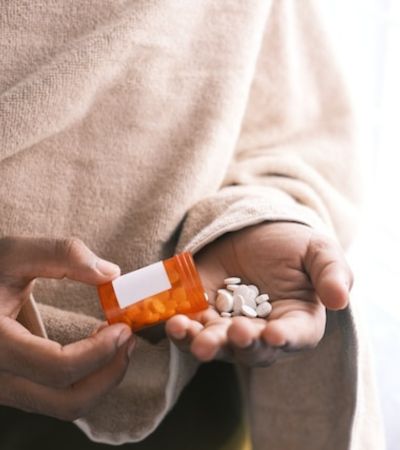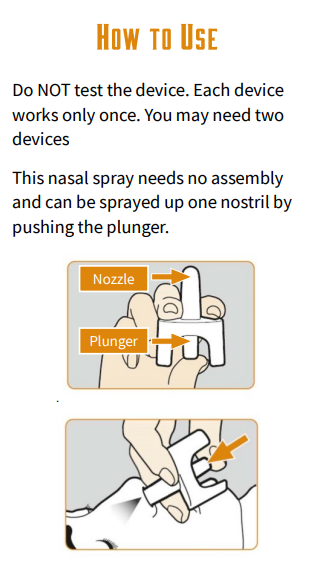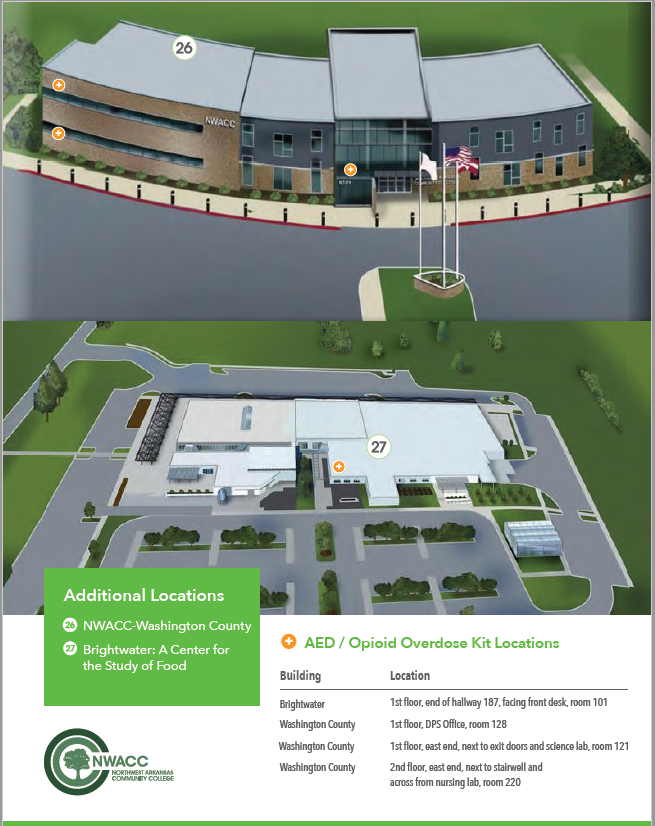Main Content Start
Opioid Overdose Rescue Kits
In compliance with Arkansas Act 811, NWACC has installed opioid overdose rescue kits in all college locations. These kits provide Naloxone (the generic name for the drug Narcan), an opioid overdose reversal medication, and are readily accessible to bystanders so they can provide life-saving intervention in the event of an opioid overdose.
Naloxone/Narcan is a safe medicine that can be administered even if you do not know what kind of drug a person took. It only reverses overdoses in people with opioids in their systems.
Someone who is overdosing may stop breathing or their breathing may be slow and labored. An overdose is life threatening so act fast!
Signs of an Overdose:
- Respiratory failure
- Slow breathing
- Small pupils
- Unresponsiveness
- Blue skin from poor circulation

How to Respond to an Overdose & Administer Naloxone/Narcan:
Instructions on how to respond to an overdose can be found below and inside the opioid overdose rescue kit itself. The kit has instructions to call 911, as well as if and when to give a second dose of Naloxone/Narcan.
NOTE: The Joshua Ashley-Pauley Act and the Opioid Antagonist Immunity Act offer protections when you call 911 and/or assist in the event of an overdose.
Step by Step Instructions:
1) Check for a Response
- Try to wake them up. Shake them and shout their name.
- Rub your knuckles hard on the center of their chest.
- Hold your ear close to their nose, listen and feel for signs of breathing.
- Look for signs of an overdose such as small pinpoint pupils and pale blue skin and nail color.
2) Call 911
- Tell the operator your exact location and say you are with a person who is not breathing.
- Tell the operator you are going to give the person Naloxone/Narcan.
- Follow any instructions you get from the operator.
3) Administer Naloxone 
- Hold the spray with your thumb on the bottom of the plunger and place your index and middle fingers on the side of the nozzle.
- Tilt the individual’s head back and support their head with your hand.
- Insert the nozzle into a nostril until your fingers on either side of the nozzle are against the bottom of the person’s nose.
- Press the plunger firmly to release the full dose.
- Review the graphic to the right and this 30-second video to learn how to administer Naloxone/Narcan nasal spray.
4) Start Rescue Breathing
- Check again if they are breathing. Someone who has overdosed needs oxygen. Naloxone may take a few minutes to start working.
- If you can't hear them breathe or their breath sounds shallow, provide rescue breaths.
- Follow instructions of 911 operator until help arrives.
5) Give a Second Dose of Naloxone
- Wait about 3 minutes for Naloxone to take effect. If the person has not responded after 3 minutes, give a second dose.
6) Provide Post Care
- Stay with the person until help arrives.
- If the person starts breathing on their own, but they do not wake up, roll them to their side to a recovery position.
- When the person wakes up, they may not remember what happened and they may be scared, nervous or restless. Keep them calm until help arrives.
Feel free to also download the Opioid Overdose Protocol Toolkit.
Location of Opioid Overdose Kits at NWACC
The following maps show the locations of the opioid overdose kits in NWACC buildings. The opioid overdose kits can be found in the same locations as the automated external defibrillators (AED) kits.
View the NWACC - Benton County Map PDF
| NWACC Building | Kit Location |
| Brightwater | 1st floor, end of hallway 187, facing front desk, room 101 |
| Burns Hall | 1st floor, main entrance, attached to the Department of Public Safety Station, room 1205 |
| Burns Hall | 1st floor, east end, in the vestibule next to room 1003 |
| Burns Hall | 1st floor, west end, inside the Fitness Center, room 1458 |
| Burns Hall | 2nd floor, west end, next to the stairwell and the Science Lab/Specimen Storage, room 2328 |
| Burns Hall | 3rd floor, central, in between the Marketing/Public Relations and Senior VP of Learning Office, rooms 3028 & 3023 |
| Center of Health Professions | 1st floor, west side, facing the mechanical pump, room 1025 |
| Center of Health Professions | 2nd floor, west side, facing the physical therapy lab, room 2027 |
| Center of Health Professions | 3rd floor, west side, facing the electrical room 3019 |
| Global Business Development Center | 1st floor, lounge 1001, next to restrooms and Learning Resources, room 1022 |
| Global Business Development Center | 2nd floor, lounge 2003, next to restrooms |
| Intergrated Design Lab | 1st floor, next to restrooms and data room 110 |
| National Child Protection Training Center | 1st floor, Study Lounge 1003, next to the video reflection rooms |
| Physical Plant | 1st floor, Training/Breakroom 109 |
| Shewmaker Center for Workforce Technologies | 1st floor, main entrance to the left of the doors, room B101 |
| Shewmaker Center for Workforce Technologies | 2nd floor, centrally located in the common areas, in front of the admin desk, room B201 |
| Student Center | 1st floor, next to the Student Information Center, room 101 |
| Student Center | 2nd floor, next to the Conference Room 221 |
| Student Center | 3rd floor, Student Lounge 301, next to women's restroom |
| Washington County Campus | 1st floor, DPS Office, room 128 |
| Washington County Campus | 1st floor, east end, next to exit doors and science lab, room 121 |
| Washington County Campus | 2nd floor, east end, next to stairwell and across from nursing lab, room 220 |

